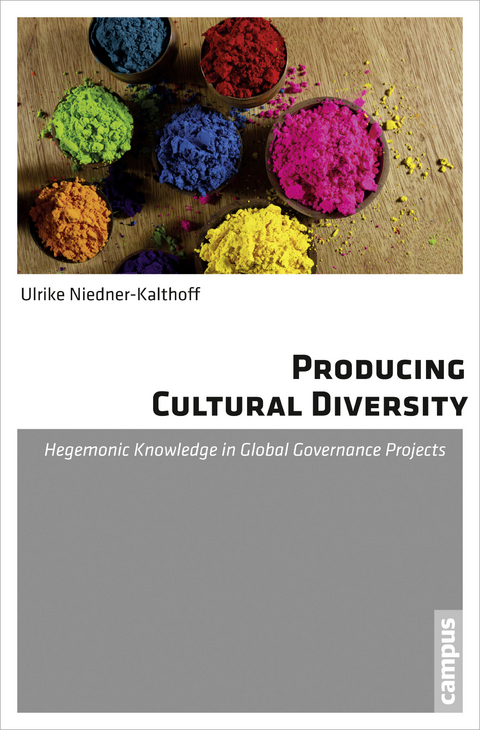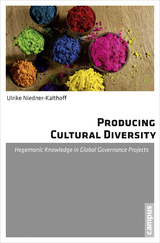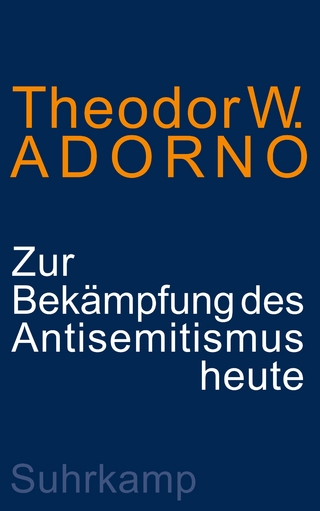Producing Cultural Diversity
spielen und wie "kulturelle Vielfalt" durch hegemoniales Wissen erst hergestellt wird. Diplomatische Praktiken - von der Konstruktion eines Themas über dessen Verhandlung und Mobilisierung bis zur Repräsentation - werden einer detaillierten Analyse unterzogen und in der Diskussion um Global Governance und Gouvernementalität verortet. Damit liefert das Buch einen zentralen Beitrag zur Anthropologie der Diplomatie und der Staatlichkeit im 21. Jahrhundert.
In ihrer Ethnografie der UNESCO-Verhandlungen zum Schutz der kulturellen Vielfalt beleuchtet Ulrike Niedner-Kalthoff die vielfältigen Prozeduren der Entscheidungsfindung im postnationalen Zeitalter. Sie zeigt, welche Rolle Technologien der Macht in Verhandlungenspielen und wie »kulturelle Vielfalt« durch hegemoniales Wissen erst hergestellt wird. Diplomatische Praktiken - von der Konstruktion eines Themas über dessen Verhandlung und Mobilisierung bis zur Repräsentation - werden einer detaillierten Analyse unterzogen und in der Diskussion um Global Governance und Gouvernementalität verortet. Damit liefert das Buch einen zentralen Beitrag zur Anthropologie der Diplomatie und der Staatlichkeit im 21. Jahrhundert.
Ulrike Niedner-Kalthoff, Dipl.-Kult., ist Referentin für europäische Zusammenarbeit im Bereich Schlüsseltechnologien im Hessischen Wirtschaftsministerium.
Contents
Acknowledgements 9
Chapter 1
Introduction: Culture and Governance 11
The Case of the Convention 15
Global Governance 16
Governmentality 24
The Convention and Neoliberalism 27
Challenges and Strategies 29
Empirical Research 34
Chapter 2
Construction: Framing the Issue of "Cultural Diversity" 39
A Genealogy of the Convention Process 42
Framing the Convention 50
The UNESCO Frame: the Imperilment of Identity, Values, and Meaning 53
The US Frame: "This Convention Is Actually About Trade" 62
The INCD Frame: "The Right of States to Do Whatever They Want" 69
Agendas and Tensions 76
Culture and Cultures 78
Chapter 3
Negotiation: Diplomatic Build-Up and Showdown 87
Structure of the Negotiations 88
The Key Conflict 92
Blackboxing Cultural Diversity 99
Culmination of the Conflict 104
The Great Debate 111
Making Sense of the Great Debate 119
Summing It Up 133
Chapter 4
Mobilization: Cultural Diversity as an Empty Signifier 137
The Coalitions for Cultural Diversity 139
Unspecific Aims 143
To Commit or Not to Commit 147
Pure Communitarian Being 154
Cultural Diversity Is Us 165
Conclusion 171
Chapter 5
Representation: Speaking for Others-Doing Cultural Diversity 173
Reenactment-Representation Taken For Granted 177
Complex Individuals-Simple Collectivities 184
Representation Contested-Assembling the World in a Nutshell 193
Honoring "the International Regions" 200
Representing/Performing Cultural Diversity 207
Concluding Remarks 215
Chapter 6
Conclusion: Globalization and Anti-Globalization 217
Looking Back in Detail: Producing/Practicing
"Cultural Diversity" 219
Globalization, Anti-Globalization, and the National Frame 223
List of Abbreviations 227
Works Cited 229
Institutional Documents238
Index243
Chapter 1
Introduction: Culture and Governance
You can expect unexpected links between people, practices, and concepts from a policy project that has the Syndicat national autonome des comédiens du Burkina (Autonomous National Union of Comedians of Burkina), the Swiss NIKE Nationale Informationsstelle für Kulturgüter-Erhaltung (National Information Center for the Preservation of Cultural Goods), and the Association of Canadian Publishers rooting for it. At the heart of this project and thus at the heart of the present study is an international treaty that not many people have a clear impression of but that has been celebrated by those involved as an exceptional diplomatic success story: the Convention on the Protection and Promotion of the Diversity of Cultural Expressions? concluded at the United Nations Educational, Scientific and Cultural Organization (UNESCO) in 2005.
This "convention" in the international legal sense, that is, this treaty, is interesting as a "convention" in a semiotic sense, too, as a case that illustrates the shaping of the relationship between a linguistic sign and its designatum, or, in other words, signifier and signified (Lévi-Strauss 1963, 91-94). Looking at how the Convention came to be does not only tell us something about how public international law is made, that is, how negotiators establish a convention about what to understand by "cultural diversity" and related concepts in strictly circumscribed legal terms. It simultaneously offers insights about how the sign "cultural diversity", originally chosen by its supporters, if not arbitrarily, then at least by a very conscious and openly strategic move as opposed to a more 'organic' development, came to impregnate the semantic content of the associated political campaign in a way that at one point the relationship between the sign and its designatum was stripped of all arbitrariness and became naturalized. The meaning of "cultural diversity" had at this point irrevocably become what those who coined the term had intended to convey, with deviating interpretations failing to assert themselves. The relationship between the signifier "cultural diversity" and its signified(s) had been shaped by a strong linguistic convention that became almost impossible to break.
The various efforts to write, lobby for, and put into practice the Convention on Cultural Diversity that constitute the core of the present study are fascinating in their form as well as in their contents. One reason for this is the stark contrast between what the treaty initially appears to be to the untrained eye and what it slowly unfolds to be when looked at through the eyes of its most passionate supporters and its most bitter opponents; another reason is the degree of skill with which its supporters shaped their political campaign both inside and outside the conference halls. Many (non-scientific) publications that deal with the Convention or the campaign leading up to it as well as many meetings, conferences, round tables and other events on this treaty frame the Convention using very strong visual stimuli on brochures, banners and the like-stimuli that encourage a primarily aesthetic and innocent reading of the project:
Fig. 1: Images illustrating the Convention on Cultural Diversity?
Broad ranges of vivid colors, smiling faces, beautiful people, objects and places with (viewed from a Western perspective) exotic allure; all these images could be used just as well on brochures for the discerning tourist as on the covers of publications elucidating an instrument of international public law. The innocent reading of the Convention prompted by such images would perceive it as a descriptive statement of celebratory nature praising the intrinsic beauty of the manifold varieties of artistic achievement sprung from human creativity around the globe-a 'carnival of cultures' stimulating the senses of those beholding this beauty in awe.
Those able to com
| Erscheint lt. Verlag | 9.2.2015 |
|---|---|
| Zusatzinfo | 1 Farbabbildung |
| Verlagsort | Frankfurt |
| Sprache | englisch |
| Maße | 142 x 214 mm |
| Gewicht | 314 g |
| Themenwelt | Sozialwissenschaften ► Ethnologie |
| Sozialwissenschaften ► Politik / Verwaltung ► Politische Theorie | |
| Schlagworte | Diplomatie • Global Governance • Gouvernementalität • Hegemonie • Hegemonie / Vormachtstellung • Machttechnologien • Nation • Staat • Staatlichkeit • UNESCO • Vielfalt,kulturelle |
| ISBN-10 | 3-593-50316-6 / 3593503166 |
| ISBN-13 | 978-3-593-50316-5 / 9783593503165 |
| Zustand | Neuware |
| Haben Sie eine Frage zum Produkt? |
aus dem Bereich




